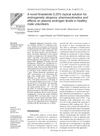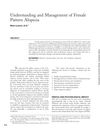TLDR Topical spironolactone works better than topical finasteride for hair loss.
The study compared the effectiveness of topical finasteride and topical spironolactone in treating androgenetic alopecia (AGA) in both males and females. The results indicated that while both treatments were effective, topical spironolactone was superior to topical finasteride. Additionally, topical applications of both medications had fewer side effects compared to their oral counterparts. The study concluded that topical spironolactone is a better option for managing AGA.
23 citations
,
April 2018 in “PubMed” Topical finasteride reduces hair loss and promotes hair growth in men and women.
 32 citations
,
June 2015 in “Dermatologic Therapy”
32 citations
,
June 2015 in “Dermatologic Therapy” Finasteride and minoxidil together work best for male hair loss.
 50 citations
,
July 2014 in “International Journal of Clinical Pharmacology and Therapeutics”
50 citations
,
July 2014 in “International Journal of Clinical Pharmacology and Therapeutics” New finasteride solution effectively reduces baldness-causing hormone, potentially with fewer side effects.
 30 citations
,
November 2008 in “Facial Plastic Surgery”
30 citations
,
November 2008 in “Facial Plastic Surgery” The conclusion is that the best approach for treating Female Pattern Hair Loss is a combination of different treatments.
 2 citations
,
January 2011 in “The Korea Journal of Herbology”
2 citations
,
January 2011 in “The Korea Journal of Herbology” Korean medicinal herbs in hair tonic and food increased hair growth in mice.
12 citations
,
February 2003 in “PubMed” Androgenetic alopecia can affect adolescents, impacting self-esteem, but minoxidil's effectiveness for them is unclear.
8 citations
,
January 1998 in “PubMed”




